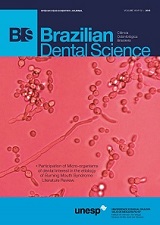Effects of Typified Propolis on Mutans Streptococci and Lactobacilli: a Randomized Clinical Trial
DOI:
https://doi.org/10.14295/bds.2013.v16i2.879Resumo
Objective: The aim of this study was to determine in a
randomized, double-blind, placebo-controlled clinical
trial the effects of typified propolis and chlorhexidine
rinses on salivary levels of mutans streptococci (MS)
and lactobacilli (LACT). Methods: One hundred
patients were screened for salivary levels of MS
>100,000 CFUs/mL of saliva. All patients presented
with at least one cavitated decayed surface. Sixty
patients met entry criteria. Subjects were adults 18-
55 years old. After restoration of cavitated lesions
patients were randomized to 3 experimental groups:
1) PROP-alcohol-free 2% typified propolis rinse (n =
20); 2) CHX- 0.12% chlorhexidine rinse; 3) PL-placebo
mouthrinse. Patients rinsed unsupervised 15 mL of
respective rinses twice a day for 1 min for 28 days.
Patients were assessed for the salivary levels of MS
(Dentocult SM) and LACT (Dentocult LB) at baseline,
7-day, 14-day, and at 28-day visits (experimental
effects) and at 45-day visit (residual effects). General
linear models were employed to analyze the data.
Results: PROP was superior to CHX at 14-day and
28-day visits in suppressing the salivary levels of MS
(p<.05). PROP was superior to PL at all visits (p < .01).
The residual effects of PROP in suppressing the salivary
levels of MS could still be observed at the 45-day visit,
where significant differences between PROP and CHX
(p < .05), were demonstrated. PROP was significantly
superior than CHX in suppressing the levels of salivary
LACT at the 28-day visit (p < .05).Conclusion: Typified
propolis rinse was effective in suppressing cariogenic
infections in caries-active patients when compared to
existing and placebo therapies.
Downloads
Downloads
Arquivos adicionais
Publicado
Como Citar
Edição
Seção
Licença
TRANSFERÊNCIA DE DIREITOS AUTORAIS E DECLARAÇÃO DE RESPONSABILIDADE
Toda a propriedade de direitos autorais do artigo "____________________________________________________________________" é transferido do autor(es) para a CIÊNCIA ODONTOLÓGICA BRASILEIRA, no caso do trabalho ser publicado. O artigo não foi publicado em outro lugar e não foi submetido simultaneamente para publicação em outra revista.
Vimos por meio deste, atestar que trabalho é original e não apresenta dados manipulados, fraude ou plágio. Fizemos contribuição científica significativa para o estudo e estamos cientes dos dados apresentados e de acordo com a versão final do artigo. Assumimos total responsabilidade pelos aspectos éticos do estudo.
Este texto deve ser impresso e assinado por todos os autores. A versão digitalizada deverá ser apresentada como arquivo suplementar durante o processo de submissão.




























